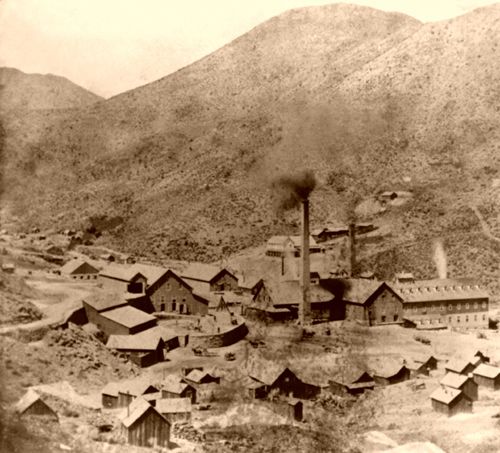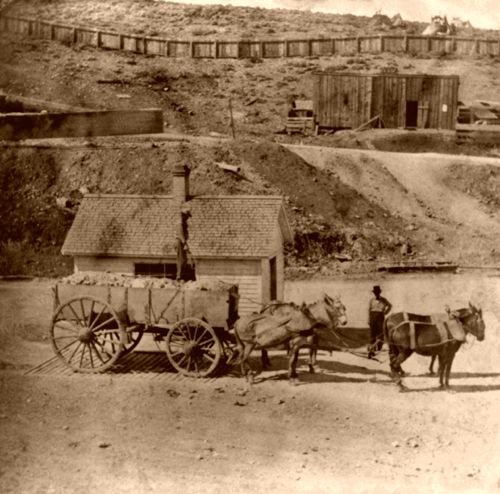By William Daugherty, 1891
Overland passengers who buy fruit of a decrepit old man at the depot, who can be seen any morning with his basket on the arrival of trains from either east or west, do not know that they are contributing to the support of Alva Gould, the original locator of the world-famed Gould & Curry mine on the Comstock. Mr. Gould is a familiar figure in Reno, Nevada. The Gazette publishes to-day a very good cut of the old gentleman made by the Gazette’s special artist from a photograph by Swisher & Bender. A biographical history of the old man will prove interesting reading to many of the Gazette’s readers.
Mr. Gould was born on June 15, 1815, and crossed the plains in 1849, arriving in Sacramento in 1850. He followed placer mining in California until 1858 when he came to the then Territory of Nevada. He discovered silver on the ground of the celebrated Gould & Curry Mine on January 6, 1859, and on January 22nd located the same. Curry was a mine jumper or “floater” as he was then termed and jumped the location Mr. Gould had made and forced Mr. Gould to take him in as a partner. Mr. Gould made arrangements with a party of prospectors to develop the mine and when they found how rich it was, managed to swindle him out of it and he never got a dollar. Curry sold his interest to Henry Meredith, who was afterward killed in a battle with the Indians at Pyramid Lake in April 1860. George Hearst, who confided in General Orlando Evans, the secret that a Dutchman by the name of Charles Dinnis had traced up the float to a high ledge on the Gould & Curry location, made a proposition to General Evans that he take a piece of the rock and go to Nevada City and interest Henry Meredith, John H. Bostwick and Sam Curtis in the enterprise for which the four men, Meredith, Curtis, Bostwick, and Evans here to pay $4,000 for 200 feet.
General Evans started for Nevada City by the Carson Canyon Route in the early part of December 1850, and about the time he left for Nevada, Meredith left by the Henness Pass Route for the Comstock and came near perishing in a snow storm. The General went to Nevada and had an assay made which showed over $9,000 per ton. The General immediately made his proposition to Bostwick and Curtis, who agreed to it, and they sent $4,000 right back to George Hearst. The following March, Evans, Curtis, and Bostwick met Hearst and Meredith in Virginia City and were informed by Hearst that it would take $8,000 instead of $4,000 to make the purchase. They put up the additional $4,000, and in the meantime, Hearst had formed a co-partnership with Bill Lent and others of San Francisco, and they in turn, succeeded in freezing Evans, Curtis, and Bostwick out, and Meredith, having been killed by the Indians, was no longer in the way.
General Evans did manage, however, to get $21,000 out of a property that was worth that many millions. Bostwick sold his interest for $1,500, and Curtis got out with a trifle. Hearst and his San Francisco partners got the mine and soon after bought Len Savage and Charley Chase’s interest in the Savage Mine.
Mr. Gould, who had been so shamefully wronged, lived on the Comstock until 1865, when he left to try his luck in Montana, and finally drifted to Cheyenne, Wyoming; Salt Lake City, Utah; and back to Colfax, California, where for a number of years he peddled fruit until 15 years ago when he came to Reno and has since been in the fruit business. In the hard winter of 1859, he went to Placerville, California for supplies and was snowed in, and when he returned he found the eight or ten miners on the lode in almost a starving condition and talking of robbing Dutch Jake’s store in Johntown. Upon hearing this, Gould immediately left for Honey Lake for more supplies. The old man was unquestionably one of the first men on the Comstock and was followed up by Henry Comstock and James Finney. He furnished the money and sent Comstock to San Francisco with the first lot of ore to have assayed. The old man’s life has been a failure in a financial way, and he is talking now of going to New Mexico to begin anew, a living illustration of Pope’s assertion, “that man never is, but always to be, blest.”
By William Daugherty, Reno Evening Gazette, March 7, 1891. Compiled and edited by Kathy Weiser/Legends of America, updated January 2021.
Also See:
Mining on the American Frontier
Pioneers on the Nevada Frontier (Reno Evening Gazette)
About the Author: Written by William Daugherty for the Reno Evening Gazette in 1891. The Reno Evening Gazette was first published on October 12, 1876, and continued for 107 years. In 1977, it was merged with the Nevada State Journal and continues to exist today as the Reno Gazette-Journal. Note: The article is not verbatim as spelling errors, minor grammatical changes, and editing have occurred for the ease of the modern reader.


